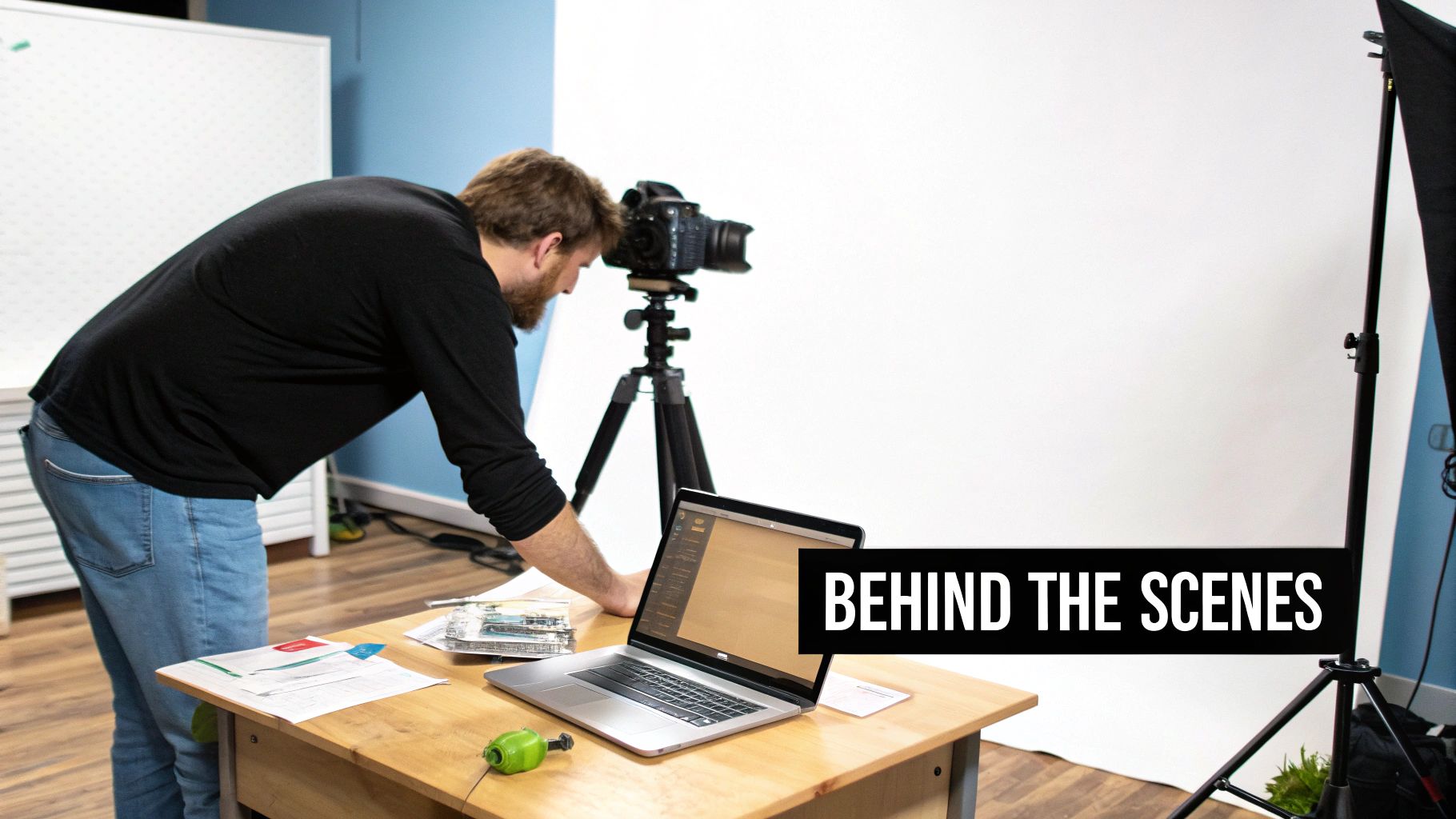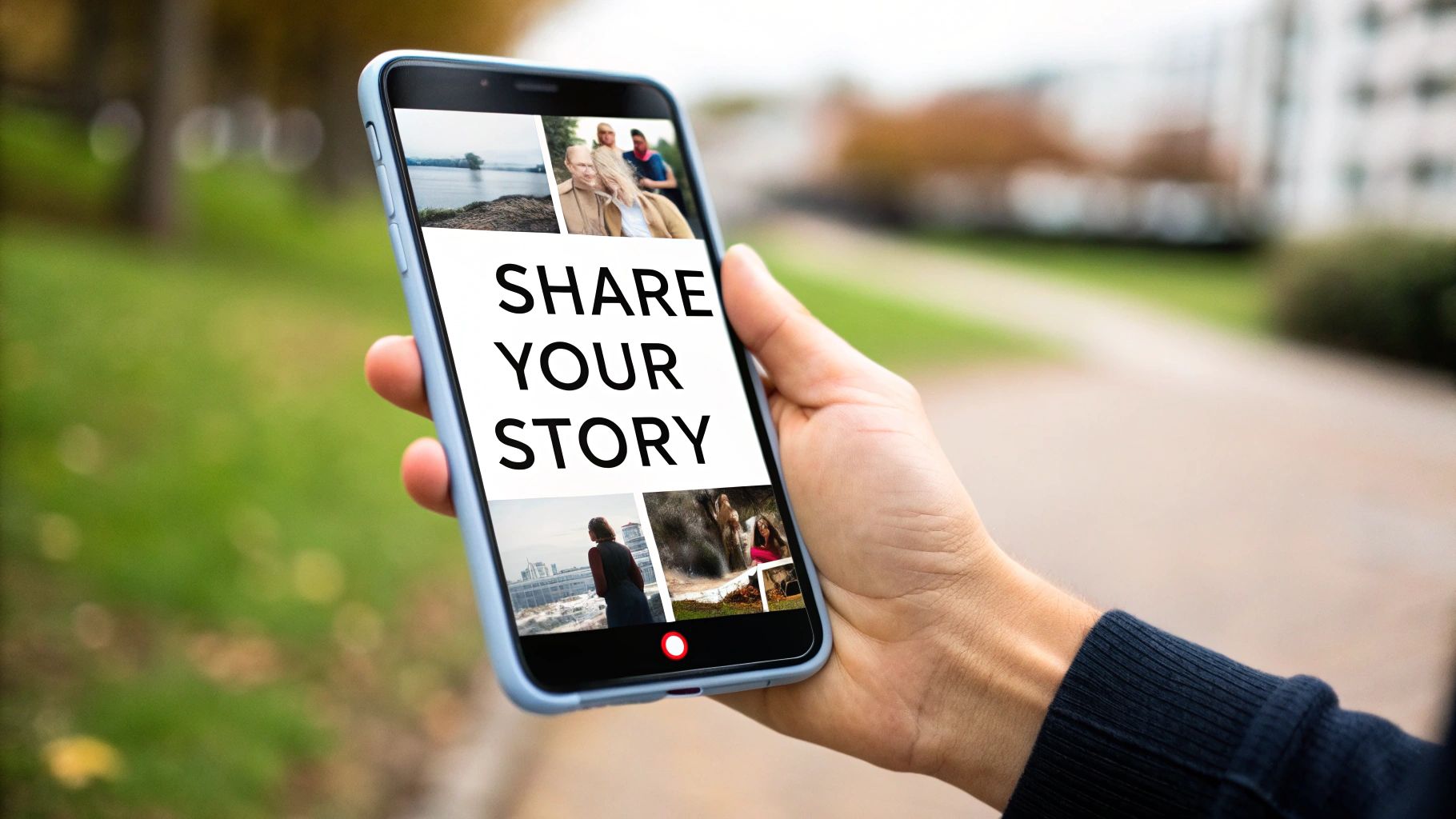In the crowded B2B SaaS marketplace, generic content no longer cuts it. To capture attention, drive engagement, and establish authority, marketers need a diverse arsenal of content that resonates deeply with sophisticated audiences. This isn't just about filling a calendar; it's about creating tangible value, sparking conversations, and building a strong presence where your future customers are actively seeking solutions, from Google search results to niche Reddit communities.
This guide moves beyond the basics, offering a curated collection of actionable content creation ideas designed to help you generate high-quality leads, improve SEO visibility, and solidify your brand's reputation. We’ll explore strategies ranging from behind-the-scenes glimpses that humanize your brand to data-driven visualizations that establish you as an industry authority.
Each idea is packed with practical examples and specific implementation tips tailored for the B2B SaaS landscape. You'll learn how to execute with precision, connect with your target audience on a deeper level, and measure the impact of your efforts effectively. This list provides the fresh perspectives needed to break through the noise and ignite your content strategy.
1. Behind-the-Scenes Content
Behind-the-scenes (BTS) content is a powerful strategy that pulls back the curtain, giving your audience an authentic glimpse into your company's inner workings. Instead of just showcasing a polished final product, BTS reveals the people, processes, and culture that make your SaaS solution possible. This approach fosters a deeper, more human connection with your audience, building trust and loyalty in a way that traditional marketing often cannot. It's an effective content creation idea because it transforms your brand from a faceless entity into a relatable team of experts working towards a common goal.

This method works exceptionally well for B2B SaaS because it demystifies complex software development and business operations. Sharing the journey, including both challenges and breakthroughs, makes your brand more transparent and approachable.
How to Implement Behind-the-Scenes Content
- Showcase the Process: Create short videos or a blog series detailing how a new feature is developed, from initial brainstorming and coding sprints to QA testing and final deployment.
- Introduce the Team: Feature "day in the life" posts or short interview clips with your engineers, product managers, or support staff. This highlights the expertise behind your product.
- Document Company Culture: Share clips from team-building events, all-hands meetings, or even casual office moments. This can be a significant asset for recruitment and brand perception.
2. User-Generated Content Campaigns
User-generated content (UGC) campaigns are a dynamic way to turn your customer base into a powerful marketing engine. This strategy involves encouraging your users to create and share content that features your SaaS product, leveraging their authentic experiences to build community and provide powerful social proof. Instead of your team creating all the content, you tap into the creativity of your real-world users, which builds trust and credibility far more effectively than traditional brand messaging. This is one of the most impactful content creation ideas because it fosters a sense of ownership and advocacy among your customers.

This method is particularly effective for B2B SaaS because it showcases tangible results and diverse use cases directly from the people using your software. Seeing peers succeed with your product is a compelling endorsement that can significantly influence purchasing decisions. To make the most of this approach, it's crucial to integrate it into your wider marketing efforts. You can discover more about incorporating UGC into your promotional mix by exploring effective B2B social media marketing strategies on pimpmysaas.com.
How to Implement User-Generated Content Campaigns
- Create a Unique Hashtag: Launch a campaign with a memorable, branded hashtag to track submissions easily across social media platforms like LinkedIn and Twitter.
- Offer Clear Incentives: Motivate participation by offering compelling rewards, such as discounts, gift cards, free upgrades, or a feature on your company's official channels.
- Showcase the Best Content: Regularly feature the best UGC submissions on your blog, social media, or website to recognize contributors and inspire others to participate.
- Keep Guidelines Simple: Ensure the rules for participation are straightforward and easy to follow. Complicated instructions can deter potential contributors.
3. Educational Tutorial and How-To Content
Educational tutorials and how-to guides are cornerstone content creation ideas that directly address your audience's pain points. This strategy involves creating step-by-step instructions that teach a specific skill or solve a common problem related to your industry. By providing tangible value and actionable solutions, you position your brand as a trusted expert and an indispensable resource, which is crucial for building authority and driving long-term customer loyalty.

This approach is highly effective for B2B SaaS companies because it not only demonstrates your product's capabilities but also empowers users to maximize its value. Tutorials that answer specific "how to" questions are often highly discoverable through search engines, attracting a motivated audience actively seeking solutions.
How to Implement Educational Tutorial Content
- Focus on Specific Problems: Create content that answers a single, searchable question your target audience has. Think about common support tickets or feature-related questions.
- Break Down Complexity: Deconstruct a complex process into a series of short, digestible steps. Use video, blog posts with screenshots, or infographics to guide users visually.
- Create Content Hubs: Group related tutorials into a larger resource center or learning academy, like HubSpot Academy, to encourage continuous learning and engagement.
- Offer Downloadable Assets: Supplement your tutorials with checklists, templates, or worksheets to provide additional value and capture leads.
4. Interactive Content Experiences
Interactive content transforms your audience from passive consumers into active participants. Instead of simply reading or watching, users engage directly with your brand through quizzes, polls, calculators, or assessments. This two-way exchange is a powerful content creation idea because it captures attention far more effectively than static content, leading to higher engagement rates and longer dwell times. It fosters a memorable experience that can generate valuable, firsthand data about your audience's needs and preferences.
This method is particularly effective for B2B SaaS companies as it can simplify complex topics. For instance, an ROI calculator can quickly demonstrate the value of your software, or a maturity assessment can help a prospect self-identify their need for your solution, generating highly qualified leads.
How to Implement Interactive Content Experiences
- Develop Value-Driven Tools: Create simple calculators (e.g., ROI, cost-saving) or assessment tools that help your audience solve a specific problem or benchmark their performance against industry standards.
- Create Engaging Quizzes and Polls: Use quizzes to test industry knowledge or help users determine which of your product tiers best fits their needs. Use polls on social media to gather quick feedback.
- Leverage Interactive Demos: Instead of a static video, create a guided, interactive product walkthrough that allows potential customers to click through key features and experience the UI firsthand.
5. Personal Story and Experience Sharing
Personal storytelling is a powerful technique that shares authentic experiences, challenges, and successes to build an emotional connection with your audience. Instead of focusing solely on product features, this approach reveals the human element behind your brand. This vulnerable, narrative-driven content is one of the most effective content creation ideas because it makes your message relatable and memorable, fostering deep trust and brand loyalty.
This method is highly effective for B2B SaaS because it humanizes technology and business. Sharing the founder's journey, the struggles behind a product launch, or a customer's success story transforms abstract solutions into compelling narratives that resonate on a personal level.
How to Implement Personal Story and Experience Sharing
- Share Your Origin Story: Write a blog post or create a video detailing why the company was founded. Focus on the problem you were passionate about solving.
- Document Failures and Lessons: Be transparent about mistakes or failed experiments. A post about a feature that didn't work and what you learned can be more valuable than a simple success story.
- Highlight Customer Journeys: Feature case studies that are framed as personal stories. Showcase a real person, their specific challenge, and how your solution helped them achieve a resolution and grow.
6. Data Visualization and Industry Insights
Data visualization is a powerful content creation idea that transforms complex industry statistics and proprietary data into compelling, easily digestible visual narratives. Instead of presenting raw numbers in spreadsheets or dense reports, this strategy uses infographics, interactive charts, and data-driven stories to capture attention and communicate insights quickly. This approach positions your brand as a data-savvy thought leader, building authority and trust by providing tangible, evidence-based value to your audience.

This method is highly effective for B2B SaaS companies because it can simplify complex topics, validate product claims, and generate shareable assets that perform well on social media and earn backlinks. By turning data into a story, like HubSpot’s annual "State of Marketing" reports, you create content that is not only informative but also memorable and engaging.
How to Implement Data Visualization and Industry Insights
- Tell a Compelling Story: Don't just present charts. Structure your data to tell a narrative with a clear beginning, a surprising insight, and a concluding takeaway that offers value to the reader.
- Use the Right Tools: Leverage platforms like Canva for simple infographics, Flourish for interactive charts, or Tableau for complex dashboards to create professional-grade visuals without extensive design skills.
- Repurpose a Single Dataset: Maximize your effort by turning a comprehensive research report into multiple content pieces, such as a main infographic, several social media graphics, a blog post, and a video summary. You can then measure the performance of your content marketing to see which formats resonate most.
7. Interview and Expert Roundup Content
Interviewing industry experts or creating roundup posts leverages external authority to build your brand’s credibility and reach. This strategy involves featuring conversations with thought leaders, customers, or internal specialists to provide your audience with diverse, high-value perspectives. Instead of relying solely on your own insights, you act as a facilitator of knowledge, connecting your audience with respected voices in the field. This is a powerful content creation idea because it borrows credibility and extends your reach into your guests' networks.
This method is particularly effective for B2B SaaS companies looking to establish themselves as a central hub of industry knowledge. By featuring prominent figures, you not only provide immense value but also gain an implicit endorsement from those experts, significantly boosting your brand's reputation and trustworthiness.
How to Implement Interview and Expert Roundup Content
- Host an Interview Series: Launch a podcast or video series featuring one-on-one conversations with industry leaders. Ask targeted questions that solve specific pain points for your SaaS audience.
- Create Expert Roundup Posts: Pose a single, compelling question to multiple experts and compile their answers into a comprehensive blog post. This creates an invaluable, shareable resource.
- Feature Customer Success Stories: Interview your most successful customers to create case studies in a Q&A format. This provides social proof and relatable stories for prospects.
8. Challenge and Transformation Content
Challenge and transformation content documents a journey toward a specific, measurable goal, creating a compelling narrative that captivates audiences. This format builds natural suspense and engagement by inviting followers to witness the entire process, including the struggles, breakthroughs, and final outcome. Instead of presenting a finished result, you share the authentic, step-by-step transformation. This is a powerful content creation idea because it humanizes your brand and builds a loyal community invested in your success.
This method is highly effective for B2B SaaS because it can demonstrate the real-world impact of your product. For example, a 30-day challenge to improve a key business metric using your software provides a tangible case study, proving your solution's value in a relatable and engaging format.
How to Implement Challenge and Transformation Content
- Launch a "Productivity Sprint": Challenge your audience to achieve a specific business goal in 30 days using your SaaS tool, documenting the journey through a blog or video series.
- Showcase Skill Acquisition: Create content around a team member learning a new skill relevant to your industry (e.g., mastering a new analytics technique), sharing progress and key learnings.
- Create a Community Challenge: Invite users to participate in a collective goal, like generating a certain number of leads with your software, and use a unique hashtag to track and feature their progress.
9. Curated Resource Lists and Toolkits
Curated resource lists and toolkits serve as a one-stop shop for your audience, gathering the best tools, articles, and resources on a specific topic. Instead of making users scour the internet, you do the heavy lifting by vetting and organizing valuable information. This approach positions your brand as a trusted industry expert and a helpful guide, providing immediate, practical value that saves your audience time and effort. It's a powerful content creation idea because it builds goodwill and establishes your site as a go-to reference hub.
This strategy is highly effective for B2B SaaS because it allows you to showcase how your product fits within a broader ecosystem of tools. By recommending complementary, non-competitive software, you demonstrate a deep understanding of your customers' entire workflow, building trust and authority.
How to Implement Curated Resource Lists and Toolkits
- Vet and Categorize: Don't just list items; personally test and evaluate each resource. Organize the list into logical categories like "for beginners," "by use case," or "free vs. paid" to make it easy to navigate.
- Add Your Unique Commentary: Provide a short, insightful blurb for each item explaining why it made the list and its ideal use case. This adds a layer of value beyond a simple collection of links.
- Create a Lead Magnet: Offer a downloadable version of the list (e.g., a PDF checklist or an Airtable template) in exchange for an email address to capture leads. For an excellent example, see this guide on the best AI marketing tools.
- Update Regularly: Keep the list fresh by reviewing and updating it quarterly or semi-annually to remove outdated links and add new, relevant resources.
10. Contrarian and Debate-Sparking Content
Contrarian content challenges conventional wisdom or popular opinions within your industry, offering a well-reasoned alternative perspective. Instead of echoing the same B2B SaaS best practices, this approach intentionally sparks debate and encourages critical thinking. This is a powerful content creation idea because it positions your brand as a confident thought leader, unafraid to question the status quo. It generates significant engagement as audiences react, discuss, and share the unexpected viewpoint.
This method is highly effective for B2B SaaS because it cuts through the noise of generic advice. By presenting a counterintuitive argument, such as why a popular marketing metric is flawed or a common workflow is inefficient, you attract an audience that values deep, strategic insight over surface-level tips.
How to Implement Contrarian Content
- Challenge a "Best Practice": Write a blog post or create a video arguing against a universally accepted industry practice. Basecamp’s book, It Doesn't Have to Be Crazy at Work, is a prime example of this.
- Ground it in Data: Your contrarian view must be backed by solid evidence, data, or a strong logical framework. It should be thought-provoking, not just provocative for the sake of attention.
- Acknowledge the Mainstream: Clearly state the popular opinion before you dismantle it. This shows you understand the landscape and builds credibility before presenting your alternative.
- Invite Discussion: Frame your content to encourage debate. End with open-ended questions that invite your audience to share their own experiences and opinions, fostering a community around the topic.
11. Live and Real-Time Content
Live and real-time content offers an unedited, immediate channel of communication with your audience, creating a sense of urgency and authenticity that pre-recorded content cannot match. This strategy capitalizes on the fear of missing out (FOMO), encouraging instant participation through formats like live Q&As, product demos, and event coverage. It's a powerful content creation idea because it humanizes your brand, allowing for direct, spontaneous interaction that builds a strong, engaged community around your SaaS product.
This approach is highly effective in the B2B SaaS space as it provides a platform to demonstrate complex features in real-time, answer prospect questions on the spot, and showcase company expertise transparently. The interactive nature of live streams builds trust and accelerates the decision-making process for potential customers.
How to Implement Live and Real-Time Content
- Host Live Product Demos: Schedule regular live sessions on platforms like LinkedIn Live or YouTube to walk through your software's key features, answering audience questions as they arise.
- Run Expert Q&A Sessions: Invite a product manager or developer to co-host a live Q&A, allowing your audience to engage directly with the experts behind your solution.
- Stream Industry Events: If you're attending or sponsoring a conference, go live to share key takeaways, interview other attendees, or give a behind-the-scenes look at the event.
12. Repurposed and Multi-Format Content
Repurposed and multi-format content is a highly efficient strategy that involves taking one core piece of content and transforming it into multiple formats for distribution across various channels. Instead of creating new material from scratch for every platform, you strategically adapt an existing asset, maximizing its value and reach. This approach is one of the most effective content creation ideas because it allows you to connect with different audience segments based on their preferred consumption habits, whether they favor video, audio, or text.
This method is ideal for B2B SaaS companies that invest heavily in creating in-depth pillar content like webinars or whitepapers. Repurposing ensures that the valuable insights within those assets are seen by the widest possible audience, driving more engagement and leads from a single creation effort.
How to Implement Repurposed and Multi-Format Content
- Start with Pillar Content: Begin with a substantial piece of content, such as a comprehensive webinar, an in-depth blog post, or a customer case study video. This will serve as your source material.
- Break It Down: Extract key concepts, quotes, and data points from the pillar content. For example, a one-hour webinar can become several short video clips for social media, a blog post summary, and a series of quote graphics.
- Adapt for Each Platform: Don't just copy-paste. Tailor the repurposed content to the format and audience of each platform. A technical point might become a detailed LinkedIn post, while a surprising statistic could be a perfect hook for a TikTok or a Reddit thread. To maximize the impact and reach of your content, explore proven content repurposing strategies.
12-Point Content Creation Comparison
Putting These Ideas into Action
The expansive list of content creation ideas we've explored moves beyond simple blog posts and social media updates. It provides a strategic framework for building a dynamic, multi-faceted content engine that captures attention, builds authority, and drives meaningful engagement for your B2B SaaS brand. From the authenticity of behind-the-scenes glimpses to the authority of data-backed industry insights, each concept offers a unique lever to pull in your marketing strategy.
The true power, however, lies not in attempting to execute all twelve ideas at once, but in strategic selection and consistent implementation. Your brand's voice, audience's needs, and specific marketing goals should be the guiding principles for choosing where to focus your creative energy first. A successful content strategy is an iterative process of testing, learning, and refining your approach based on what resonates most deeply with your target customers.
Key Takeaways for Your Content Strategy
To transform this inspiration into tangible results, concentrate on these core principles:
- Prioritize Value Over Volume: Whether you're creating an interactive quiz or a detailed tutorial, the primary goal is to provide genuine, actionable value. A single, high-impact piece of content will always outperform a dozen mediocre ones.
- Embrace Diversity in Formats: Don't get stuck in a single format. Repurposing a deep-dive webinar into short video clips, an infographic, and a series of Reddit discussion prompts allows you to maximize reach and cater to different consumption preferences. This approach ensures your best content creation ideas achieve their maximum potential impact.
- Listen to Your Audience: The most brilliant ideas come from understanding your audience's pain points. Use user-generated content campaigns, interview series, and community discussions (especially on platforms like Reddit) to keep a pulse on what your audience is talking about and what problems they need solved.
Your Actionable Next Steps
Feeling inspired is the first step; taking action is what generates ROI. To truly scale your efforts and maintain momentum, it's crucial to build efficient systems. As you begin implementing these varied content creation ideas, your team's capacity will be tested. This is where understanding and implementing content automation strategies can be a game-changer, helping you streamline repetitive tasks from content scheduling to performance tracking, freeing up your team to focus on creativity and strategy.
Ultimately, mastering content creation is about building a library of assets that serves your audience and your business long-term. By consistently applying these fresh perspectives and committing to quality, you're not just filling a calendar; you are building a brand that educates, engages, and earns trust in a crowded marketplace.
Ready to get your best content in front of authentic, high-intent audiences?
Many of these ideas thrive on community engagement. PimpMySaaS specializes in getting your B2B SaaS content discovered and discussed in targeted Reddit communities, driving brand visibility and high-quality traffic. Visit PimpMySaaS to see how we can amplify your content strategy.
